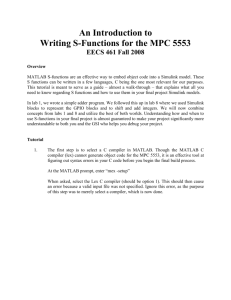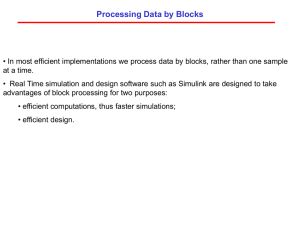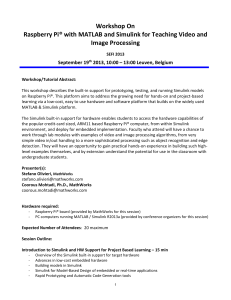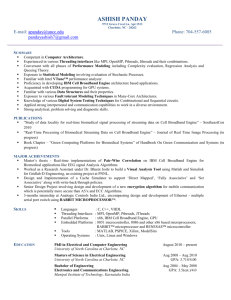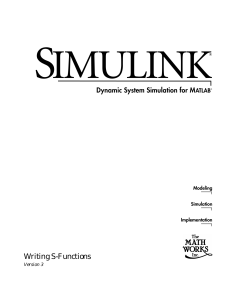notes on building real-time applications with matlab
advertisement
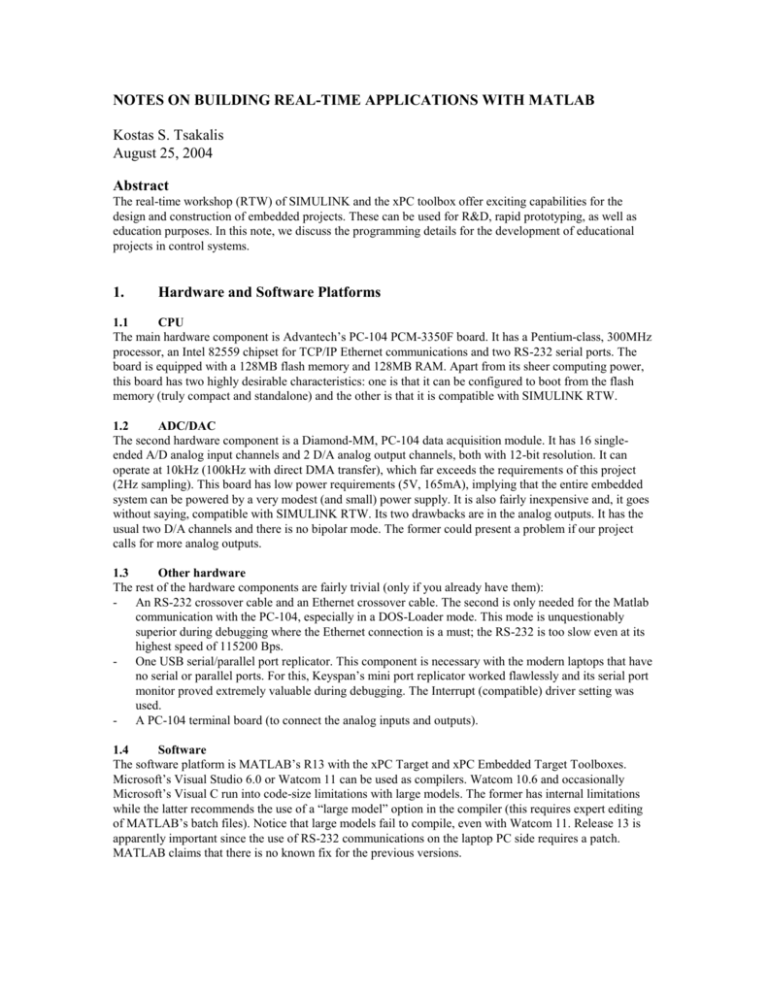
NOTES ON BUILDING REAL-TIME APPLICATIONS WITH MATLAB
Kostas S. Tsakalis
August 25, 2004
Abstract
The real-time workshop (RTW) of SIMULINK and the xPC toolbox offer exciting capabilities for the
design and construction of embedded projects. These can be used for R&D, rapid prototyping, as well as
education purposes. In this note, we discuss the programming details for the development of educational
projects in control systems.
1.
Hardware and Software Platforms
1.1
CPU
The main hardware component is Advantech’s PC-104 PCM-3350F board. It has a Pentium-class, 300MHz
processor, an Intel 82559 chipset for TCP/IP Ethernet communications and two RS-232 serial ports. The
board is equipped with a 128MB flash memory and 128MB RAM. Apart from its sheer computing power,
this board has two highly desirable characteristics: one is that it can be configured to boot from the flash
memory (truly compact and standalone) and the other is that it is compatible with SIMULINK RTW.
1.2
ADC/DAC
The second hardware component is a Diamond-MM, PC-104 data acquisition module. It has 16 singleended A/D analog input channels and 2 D/A analog output channels, both with 12-bit resolution. It can
operate at 10kHz (100kHz with direct DMA transfer), which far exceeds the requirements of this project
(2Hz sampling). This board has low power requirements (5V, 165mA), implying that the entire embedded
system can be powered by a very modest (and small) power supply. It is also fairly inexpensive and, it goes
without saying, compatible with SIMULINK RTW. Its two drawbacks are in the analog outputs. It has the
usual two D/A channels and there is no bipolar mode. The former could present a problem if our project
calls for more analog outputs.
1.3
Other hardware
The rest of the hardware components are fairly trivial (only if you already have them):
- An RS-232 crossover cable and an Ethernet crossover cable. The second is only needed for the Matlab
communication with the PC-104, especially in a DOS-Loader mode. This mode is unquestionably
superior during debugging where the Ethernet connection is a must; the RS-232 is too slow even at its
highest speed of 115200 Bps.
- One USB serial/parallel port replicator. This component is necessary with the modern laptops that have
no serial or parallel ports. For this, Keyspan’s mini port replicator worked flawlessly and its serial port
monitor proved extremely valuable during debugging. The Interrupt (compatible) driver setting was
used.
- A PC-104 terminal board (to connect the analog inputs and outputs).
1.4
Software
The software platform is MATLAB’s R13 with the xPC Target and xPC Embedded Target Toolboxes.
Microsoft’s Visual Studio 6.0 or Watcom 11 can be used as compilers. Watcom 10.6 and occasionally
Microsoft’s Visual C run into code-size limitations with large models. The former has internal limitations
while the latter recommends the use of a “large model” option in the compiler (this requires expert editing
of MATLAB’s batch files). Notice that large models fail to compile, even with Watcom 11. Release 13 is
apparently important since the use of RS-232 communications on the laptop PC side requires a patch.
MATLAB claims that there is no known fix for the previous versions.
2.
Creation of Real-Time executable code in SIMULINK/RTW
Once the model is coded in Simulink, the creation of a real-time executable code promises to be a fairly
automatic and painless process. However, this is accurate only in the later stages of development where
most of the details have been ironed out. This is also exactly the point where each application presents its
own individual difficulties that are rarely covered in the standard manual examples. We focus on a D/A
conversion to provide analog outputs, an A/D conversion to check the results and assess quantization issues,
and RS-232 serial communication with the host PC.
2.1
ADC/DAC
The analog I/O blocks present no difficulty, at least after reading the manual and correctly configuring the
board jumpers. The Diamond drivers contained in the xPC Toolbox worked flawlessly, although they do not
exploit all the capabilities of the board.
2.2
Serial Communication
The RS-232 serial communication functions present problems both in the embedded code (xPC) and the
host PC code (MATLAB-commands).
On the xPC side the main issue is the apparent incompatibility of the recommended v.2 RS-232 with “sfunctions” in the Simulink model. (S-functions and v.2 RS-232 create terminal errors at compilation or
link.) The v.1 RS-232 functions from the xPC toolbox appear to offer a solution. Other than that, serial
communication in xPC is reasonably smooth.
On the host PC side, the RS-232 drivers are implemented in Java and are available only for MATLAB V.6
(R12) or later. For the earlier versions, these drivers were flawed and would freeze the PC. At this point
(June 2003) new functions are available for R13, fixing this problem but should be installed by the user.
(For later versions, e.g., R14, these problems should be fixed without patches.) A second issue is the
inability of the drivers to handle too many bytes at a time. This is not related to any lack of time to perform
the transfer. Instead, it is likely that this is a Windows limitation. Of course, Windows is not a real-time
operating system and the various background services tend to make it very unpredictable for real-time tasks.
One remedy is to break down a long message into shorter ones and use several transmission/reception
blocks with subsequent decoding of the received messages. Also, during a run, multiple Windows tasks
should be avoided and mechanisms should be implemented to deal with missing data.
2.3
S-functions
S-functions in Simulink can speed-up significantly the compilation, execution and target-host
communication of models. This process is fairly quick and painless (it is an RTW option) and reduces
considerably the time to create the final embedded real-time code. It also provides a 10x speed-up of nonreal-time execution in our application. When the model contains custom s-functions, the build procedure
becomes a little more complicated. Using the “s-function builder” block, s-functions can be defined in a
somewhat straightforward manner. This block offers the ability to produce automatically .tlc files that are
necessary for the creation of real-time standalone executables. The intricacy in coding these functions
comes from passing the function arguments as pointers. This is a SIMULINK convention and a careful
reading of the manual or on-line help is a must. Once this is resolved, a moderately experienced C
programmer can easily code and compile custom code. No further adjustments are necessary to produce
standalone executables with s-function builder blocks that appear on the “top layer” of SIMULINK (make
sure the TLC generation option is checked). On the other hand, when these s-function builder blocks are
nested inside RTW S-functions (s-function blocks created by an RTW auto-coding process) it is necessary
to adjust the SIMULINK build parameters to reflect the use of additional objects during the link process.
Failure to do so results in a message “undefined symbol filename_Outputs_wrapper.”
This function is defined by the s-function builder block inside the file “filename_wrapper” and this is
exactly the file that must be added as a link object. The easiest way to do this is to adjust the parameters of
the SIMULINK block that contains the user-defined function. The command for this is
set_param('SfunctionObject','SFunctionModules','filename_wrapper')
where “SfunctionObject” is the complete name of the s-function containing the custom code and “filename”
is the name of the custom s-function created by the s-function build block (multiple file names can be
entered, separated by space).
2.4
Summary of the Procedure to Build Real-Time Executables
With the above comments, the creation of a real-time executable becomes routine and painless, as
promised:
1.
2.
3.
4.
5.
6.
7.
Run xpcsetup to define the xPC communication and auto-coding parameters. Use small or
medium “max. code size” (2-4MB) since the 16MB option is unsupported for embedded standalone
codes. The standalone option (requires xPC embedded Target) or DOS-Loader are suitable for PC-104
boards booting from the flash disk.
Select the communication parameters, preferably TCP/IP. For RS-232, only COM1 and COM2 can
be used (fortunately, the Keyspan driver can be reconfigured to use COM2). Of course, the RS-232
choice prohibits the use of the serial port for transmitting any other messages and it was hard and
expensive enough to get one COM port in our laptop. For the TCP/IP setup, make sure that the laptop
host has a fixed address. Then increment it by one for the PC-104. E.g., use 169.192.1.0 in the host,
169.192.1.1 in the target and 255.255.0.0, for TCP/IP subnet mask in both. Then, use 223.255.0.0 for
the Gateway in the PC and 255.255.255.255 in the target, signifying direct connection. Also make sure
that the correct chipset is selected (Advantech uses the I52559 and the bus is PCI).
For the DOS-Loader mode, create a boot disk. This requires a DOS booting disk, which is a
straightforward task in Win98 or earlier. It cannot be made in Win NT, XP etc. The program
performing this function is an m-file but expects the boot disk in A:. This is a minor inconvenience that
should have been anticipated (laptops rarely come with a disk drive any more). Simply replace every
occurrence of “A:” with “E:” (or the appropriate drive letter for the flash reader in the laptop). Use the
boot disk (i.e., flash) and startup the PC-104. If a monitor is unavailable, issue successive
“xpctargetping” commands at the Matlab prompt to make sure that the PC-104 has finished booting.
Open the Simulink model file containing the embedded system. Make sure that the simulation
parameters are set for Discrete, and in the RTW pane, the xPCTarget makefile is selected. Defaults for
the rest work fine. Also make sure that any parameters are initialized in the Matlab command window,
as necessary.
Right-click on the model core, representing the bulk of the computational load, and select
“RTW>Create S-Function.” The driver will prompt for parameters to be made external. No selection
is necessary, unless the code is to be reused with minor adjustments. If need be, the S-function creation
can always be repeated from scratch. After successfully completing the build process, the S-function
will appear in a new window, having exactly the same size and I/O structure as the original model.
Using cut and paste, replace the original Simulink block with the S-function block and save the new
model (make sure you save a copy of the Simulink model in a separate file).
If there are custom s-functions nested inside the block converted to an RTW S-function, return
to the command window and set its link parameters. (This step is not necessary if the RTW Sfunction conversion is only to be used for faster simulation within SIMULINK.) In our case, the model
file name is “sfurnace_v2.mdl” and the RTW S-function has the name “Sfurnace_v2.1” which is by
default the same as the original block but can be edited as desired. This block is masked to have the
same size and appearance as the original block. Right click on this block to see under the mask and get
the name of the masked block. By default, this is the same as the original block with the extension
“_sfcn”. Again, this name can be edited and in our case is “Sfurnacev21_sfcn”. This function contains
the user-defined s-function “s_sew”. Then, at the command window issue the following command to
include the “s_sew_wrapper” object code in the link process:
set_param('sfurnace_v2/SFurnace_v2.1/SFurnacev21_sfcn','SFunctionModu
les','s_sew_wrapper')
Build the embedded real-time code. For a standalone mode, it is sufficient to enter CTRL-B at the
Simulink model window. This will create a <filename>_xpc_emb folder with the three files to be
transferred to the flash disk. This disk must be a DOS booting disk but should not contain the DOSLoader files.
8.
3.
For the DOS-Loader option, an alternative to CTRL-B build is to run the “xpcrctool” function
at the command window. This will open the monitoring tool in a new window. Clicking on the “build
model” button will initiate the build process, ending with the download of the executable code to the
PC-104. Using the “xpcrctool” the program can then be executed, stopped and the results can be
graphed from the host PC.
Example of Communication with the Host PC
The RS-232 serial communication with the host PC finds application in the problem where a PC-resident
program controls a process that is operated or simulated externally. Input/output measurements are
communicated back and forth through the serial port (e.g., with the use of smart sensors and actuators).
The block diagram of such a controller is shown in Fig. 4. This model generates the commands, views and
stores data and communicates with the target. The communication with the target is performed by the
“Furnace Communication” block, whose components are shown in Fig. 5. The main communication is
performed by the MATLAB function block while the rest of the blocks perform multiplexing and demultiplexing of the various signals. The communication function is written as an “.m file,” accepting two
inputs, providing one output, and using the MATLAB serial commands to access the serial port.
There are two important issues that this function must resolve:
One is to make sure that the output vector contains the most recent message; this is achieved in an
initialization step reading all messages in the RS-232 buffer (this step is performed only the first time
the function is executed).
The second is to make sure that the transmission port is empty before sending the control signals to the
target.
The block diagram of the control algorithm subsystem is shown in Fig. 6. It includes 5 decoupled PID’s and
a simple mechanism to handle missing data or communication errors. More specifically, if the
communication function does not receive data correctly, it outputs a zero measurement vector. When this is
detected at the PID input, the last measurement is transmitted to the PID’s in order to preserve the
continuity of the control input.
Finally, the read/write message formats should be consistently defined in both the target and host. The
source codes for the communication function and the target RS-232 message formats are given in the
Appendix. At this point, it is convenient to normalize all transmitted data to contain a fixed number of
bytes. Using the C ‘8f’ format, each number is transmitted as a floating point with 6 decimals. Thus, using a
scaling parameter so that all numbers are less than 10, guarantees that all numbers are transmitted as 8-byte
messages plus 1-byte comma separators. The 25 variables will then be transmitted in 225 bytes including 1
byte for the “#” terminator. Fixing the size of the message is not crucial for its transmission or reception.
But it helps to identify if a complete message has been received by simply checking the “BytesAvailable”
variable.
Figure 1: Block diagram of the Controller top layer.
Figure 2: Block diagram of the Controller serial communication subsystem.
Figure 3: Block diagram of the controller subsystem, including a simple missing data handling
mechanism.
APPENDIX
A1. Controller RS-232 communication function source code.
function xp=fur_com1(U,s_2);
% Furnace communication function
% Inputs: Control vector, Serial object
% Outputs: Output vector (Temperatures, applied power, flags)
% KST 7/7/03
t0=clock;
g5='%8f,%8f,%8f,%8f,%8f,';g3='%8f,%8f,%8f';
% R/W format
g5e='%8f,%8f,%8f,%8f,%8f';
xp0=zeros(25,1); xp1=xp0;
% Init
x0=sprintf([g5,g5,g5,g5,g5e,'#'],xp0);
Init_flag = U(length(U));
% Flags
if Init_flag == 0
% Init RS232
while s_2.BytesAvailable < 225 & etime(clock,t0) < 5; end
while ~isempty(x0)
% Empty buffer
x1=x0;
x0=fscanf(s_2);
end
xp0=sscanf(x1,'%f,');
% last value
Init_flag=1;
else
while s_2.BytesAvailable < 225 & etime(clock,t0) < 5; end % Read message
x0=fscanf(s_2);
xp0=sscanf(x0,'%f,');
if s_2.BytesAvailable >0; Init_flag=0;end % Enforce empty buffer
end
if length(xp0) ~= 25; xp0 = zeros(25,1); Init_flag=0; end
Up=sprintf([g5,g3,'#'],[U(1:length(U)-1)]);
ez=0;t1=clock;
while ez == 0
% Check for busy TX port
b=s_2.TransferStatus; dt = etime(clock,t1);
ez = (dt >= 0.2) + (length(b) == 4);
% Idle or Read status
end
if dt < 0.2; fwrite(s_2,Up,'async'); end
% Send control message
dt1=etime(clock,t1);
dt0=etime(clock,t0);
xp = [xp0(2:25)*Init_flag;Init_flag;0.2-dt;dt1;dt0];
A2. Controller RS-232 initialization.
%sample code for serial communication
warning off MATLAB:serial:fscanf:unsuccessfulRead
s_2 = serial('COM2','BaudRate',115200,'FlowControl','software','Timeout',.05);
s_2.InputBufferSize=1024; s_2.OutputBufferSize=1024; s_2.Terminator=35;
fopen(s_2);
% initialize controller parameters
Tsa=0.5; decim=1; PID=[.02 100 100/4];
